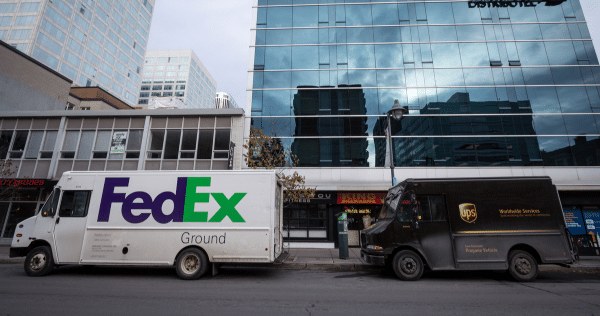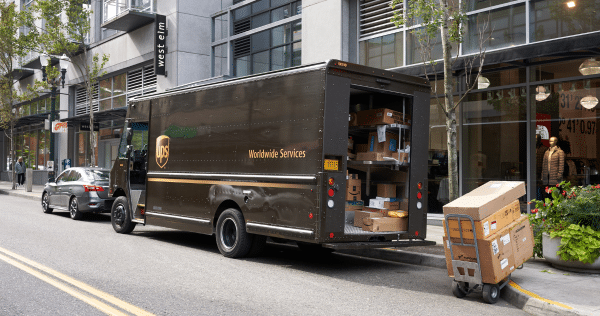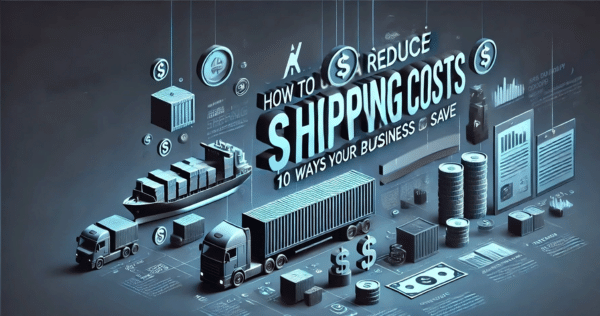What Is Parcel Spend Management?
Parcel spend management is the process of analyzing and optimizing your shipping costs to reduce parcel delivery expenses. It involves negotiating favorable rates and services from shippers, auditing parcel invoices, and automating logistics to increase efficiency without lowering service quality.
Effectively managing your parcel spend is essential for cutting shipping costs and improving efficiency. Even the smallest oversight can lead to significant overpayment or lower service quality, hurting your bottom line and customer experience.
The process generally involves:
- Conducting parcel audits to uncover overpayments
- Negotiating carrier rates to lower shipping costs and accessorial fees
- Optimizing shipping processes through consolidated shipments and packaging optimization
- Streamlining operations with technology that generates data reports to help you optimize your supply chain
All shippers should focus on parcel spend management to maintain higher customer satisfaction and reduce spending. However, it’s most important for large-scale shippers who can save a ton of money by reducing costs by just a few percent.
5 Essential Strategies for Improving Your Parcel Spend Management
Parcel spend management aims to lower shipping costs. It’s an essential practice for improving your bottom line, and with the right strategies, it can even improve your service quality.
Here are five parcel spend management best practices you can implement to save money.
Negotiating Carrier Contracts
Carrier contracts control the costs of shipping and additional services, which set the base for your total parcel spend and determine how much you can recover from overcharges and billing errors.
You can negotiate loyalty or volume discounts to help lower shipping costs and fuel or accessorial fee surcharges to help make costs more consistent.
Optimizing Packaging
The weight and size of your parcels significantly impact your parcel spend. The more space it takes up, the fewer parcels can fit in one delivery. Plus, heavy packages use more fuel, increasing costs.
Optimizing your packaging helps your parcels take up less space and weight overall, lowering your base shipping costs. Optimized packaging also helps you spend less on materials and makes it easier to streamline packing processes.
Automating Logistics
Shipping itself isn’t the only cost associated with your parcel spending. There are also logistics processes like choosing the right shipping method, printing labels, and tracking packages that you can automate with transportation management software to save on labor costs and reduce errors.
Analyzing Data for Insights
There’s a lot of data involved in shipping–and with the right tools, you can gather and analyze it to uncover shipping optimizations you can make to reduce costs.
For example, finding shorter shipping routes to save time and gas on delivery and identifying which carriers are most cost-effective are a few ways to lower shipping costs using insights from data.
Conducting Parcel Audits
If you want to manage your parcel spend effectively, the secret is to avoid overpaying.
Billing mistakes are common in shipping, especially for high-volume contracts. Small shipping rate miscalculations due to mismeasured parcels and unnecessary accessorial fees added to invoices can increase.
Fortunately, parcel invoice auditing uncovers billing errors, overcharges, and unnecessary expenses that don’t adhere to your carrier agreement. This way, you can avoid paying more than you need to, helping with cost reduction.
The Importance of Carrier Contracts in Spend Management
Any effective parcel spend management strategy is built around cost-effective carrier contracts. They’re the basis of your relationship with a carrier, outlining all critical logistical information so both parties can maintain expectations and standards while conducting business.
These agreements define specific rates and surcharges for services, conditions for receiving refunds or making payments, and delivery terms to ensure predictable costs and service levels.
You can also use carrier contracts to negotiate special rates and discounts based on things like shipping volume, the length of your shipper-carrier relationship, and rates from other carriers. Or, you may want to request specific shipping options or accessorial services to fit your business’s needs.
Carrier contracts are at the core of invoice auditing, reducing shipping costs, and maintaining high-quality standards. If you want to maximize performance and cost-efficiency, you need to master carrier contracts–including leveraging them to negotiate better terms.
Strategies for Negotiating Better Carrier Terms
Negotiating carrier contracts is one of the best ways to secure consistent savings that lower your shipping spend. It can be a complicated process, but with the right strategies, you’ll have a better chance of improving your shipping terms.
An important factor in negotiating better terms is your carrier relationships. The better your relationship, the more likely they are to work with you on changing terms. You can improve your relationships, though:
- Prompt communication in resolving problems
- Clear expectations and terms that you adhere to
- Consistent and high-volume shipping
- Timely payments and flexible payment methods
- Recognizing excellent service and performance
- Collaboration with carriers to identify issues and come up with proactive solutions
You should also conduct regular freight and parcel audits on carrier invoices to review performance metrics and service costs and ensure that you’re getting enough value from that relationship. If you aren’t, you can use this data to negotiate better terms or leave the contract and use another carrier.
The Role of Service-Level Agreements (SLAs) for Performance
Service-level agreements (SLAs) are crucial for ensuring that carriers meet specified performance standards. SLAs outline:
- Delivery times for different shipping speeds
- Accuracy expectations for high-quality service
- Handling requirements for fragile or perishable parcels
- Visibility requirements for tracking services
- Response times to disputes
These terms help you ensure your customers receive a great experience and set the grounds for compensation if the carrier fails to uphold them. For example, if a shipping method consistently arrives later than outlined in the SLA, you can use that to negotiate lower pricing and adjust customer expectations.
How Optimizing Packaging Reduces Dimensional Weight Charges
Packaging optimization can help you control costs by reducing dimensional weight charges. Every cubic inch and ounce counts in parcel shipping, making it essential to minimize the size and weight of packages wherever possible. Plus, proper packaging design also ensures product safety and regulatory compliance.
By understanding and implementing these strategies, you can significantly reduce your parcel spend and improve shipping efficiency.
The Financial Impact of Packaging Choices
The type and size of packing materials you use determines how large and heavy your parcel is. Compact packaging allows more parcels to fit in a shipment, reducing the amount of space they take up and reducing costs as more parcels can fit at once. Choosing a lightweight material that’s sturdy enough for your shipment also limits shipping weight and keeps costs down.
By making mindful packaging choices, you can save money and improve your bottom line without lowering service quality.
How Automation Helps Optimize Your Shipping Processes
Automation plays a major role in streamlining shipping processes to improve your supply chain efficiency and cost-effectiveness by increasing accuracy and speed. According to a 2018 McKinsey study, well-executed automation can lead to a 25-55% reduction in costs and a 10-35% increase in productivity.
Fortunately, modern shipping software and management systems allow you to achieve these improvements in a fraction of the time. Here are just a few ways a program can help:
- Automating label generation reduces errors and misdirected shipments.
- Automated shipping systems handle complex administrative tasks to ensure compliance and minimize errors.
- Advanced transportation management systems (TMS) enhance visibility, automate processes, and identify optimization opportunities.
- Real-time tracking tools help maintain transparency and reliability in the delivery process.
- Advanced algorithms predict future shipping needs and optimize transportation modes to improve efficiency.
While these programs can help you do more with less, you need to choose the right software if you want to maximize your savings.
Choosing the Right Shipping Software
The right shipping software streamlines your operations and provides valuable insight into your shipping process, helping you reduce errors and minimize wasted spending.
Your choice should provide real-time tracking and issue resolution support, which will help you maintain higher customer satisfaction. You should also look for real-time pricing calculations, which will help you estimate shipping costs and prepare shipments more efficiently.
Choosing the right shipping software can optimize your shipping processes and reduce costs.
The Benefits of Data Analytics for Parcel Spend Management
Data analytics generate insights that help you optimize your supply chain and logistics management. You can leverage these insights to inform and simplify the decision-making processes that help optimize operations and reduce costs.
Here’s how shipping analysis helps.
Collecting and Analyzing Shipping Data
Parcel audit software centralizes all shipping data, providing a comprehensive view of parcel carrier performance and shipping costs that you can reference when making logistical decisions. Integrating data from various sources, including historical shipments, market trends, and sensor data, is also essential for comprehensive analysis and is possible with a transportation management system.
Analyzing historical data helps you:
- Identify fluctuations in market demand
- Plan strategies to meet market demand efficiently
- Make informed decisions
- Optimize shipping operations
- Improve efficiency
- Identify and reduce unnecessary expenses
With this data, you can more effectively cut costs, negotiate with small parcel carriers, and forecast shipping spending for predictable budgeting.
Identifying Cost-Saving Opportunities Through Data
Analyzing your shipping data with intelligent audit platforms makes it much easier to identify obstacles, challenges, and optimizations thanks to real-time analytics.
Scenario planning with analytics can identify cost-saving opportunities by testing different network scenarios and carrier combinations. With predictive analysis, you can forecast demand and potential challenges, helping to anticipate and mitigate cost issues. Using data visualization tools also helps you analyze shipping patterns effectively, identifying areas for improvement.
By leveraging these tools, you can uncover actionable insights that lead to cost savings and enhanced operational efficiency.
The Role of Parcel Auditing in Spend Management
Parcel audits provide visibility into both individual transactions and broad trends. With the help of a comprehensive parcel auditing solution like Zero Down, you’ll have enhanced visibility that allows you to make informed decisions about your shipping process.
How Parcel Audits Improve Visibility and Lower Spending
A parcel audit looks at the invoices you receive from all your carriers, analyzes the charges you’ve received, and checks to ensure they’re accurate. It’s a key step in collecting refunds from overspending due to billing errors, which can lower your shipping spend by as much as 15%.
Parcel audit solutions offer several benefits, including:
- Streamlining the auditing process, reducing the time needed to match invoices with contracts from days to just hours
- Minimizing human errors and ensuring greater accuracy in detecting discrepancies in parcel invoices
- Revealing trends and cost-saving opportunities through regular audits, allowing for more informed decision-making.
With comprehensive data from audit software, you can better forecast your future parcel spend by identifying trends in spending. It’ll also help you avoid paying duplicate charges, undelivered packages, and other unnecessary expenses that cost you money.
The Benefits of Visibility: How Zero Down Found A Client 18% More Savings
Data is the backbone of transportation spend management. If your logistics platform doesn’t look closely enough, you’ll miss improvement and savings opportunities—and that’s what happened to a Zero Down client.
After receiving a parcel optimization analysis from a competitor, this client came to Zero Down to double-check their report. With the help of the FreightOptics™ advanced logistics platform, they were able to identify specifically where the previous analysis went wrong and find 18% more savings that were missed previously.
Ship Smarter with Parcel Spend Management
Effective parcel spend management requires a diverse approach, including negotiating carrier contracts, optimizing packaging, leveraging automation, utilizing data analytics, and maintaining strong carrier relationships. Each strategy plays a crucial role in reducing shipping costs and enhancing overall efficiency.
By implementing these proven strategies, you can achieve significant cost savings and gain full control over your shipping operations. And it’s easy with Zero Down’s TMS and auditing solutions.
Frequently Asked Questions
How do carrier contracts impact parcel spend management?
Carrier contracts impact parcel spend management by defining specific rates, surcharges, and conditions for small parcel shipping. These values help businesses set expectations for costs and service levels to help optimize the shipping process.
What are the benefits of optimizing packaging for parcel shipping?
Optimizing packaging for parcel shipping can help minimize dimensional weight charges, reduce overall shipping costs, and ensure product safety and regulatory compliance.
How can automation reduce shipping costs?
Automation reduces shipping costs by streamlining shipping processes, minimizing manual errors, highlighting optimizations, and identifying billing errors.
Why is data analytics important in parcel spend management?
Data analytics provides insights to help optimize supply chain performance and shipping efficiency, reducing shipping costs and improving decision-making.
How does auditing improve spend visibility and control?
Auditing improves parcel spend visibility by carefully reviewing all charges, verifying them, and highlighting opportunities for refunds. You can use this information to negotiate with carriers and recoup overcharges for reduced shipping spend.
Brad McBride, CEO and Founder of Zero Down Supply Chain Solutions is a dynamic leader with over 30 years of experience in the supply chain sector. His journey began at Consolidated Freightways in 1988, where he mastered freight logistics and pricing. His career led him to Eagle Global Logistics, diving into international freight forwarding and leading high-volume shipping projects.
Read More




